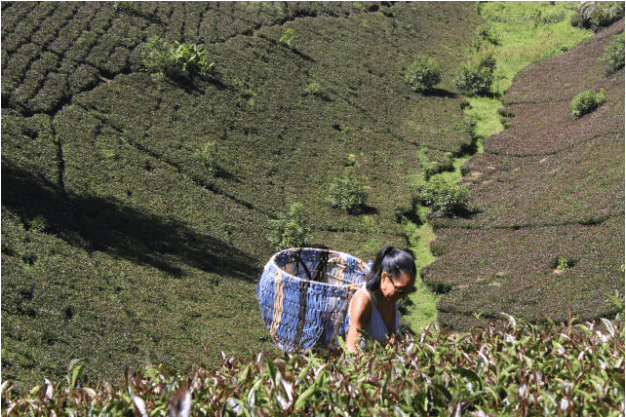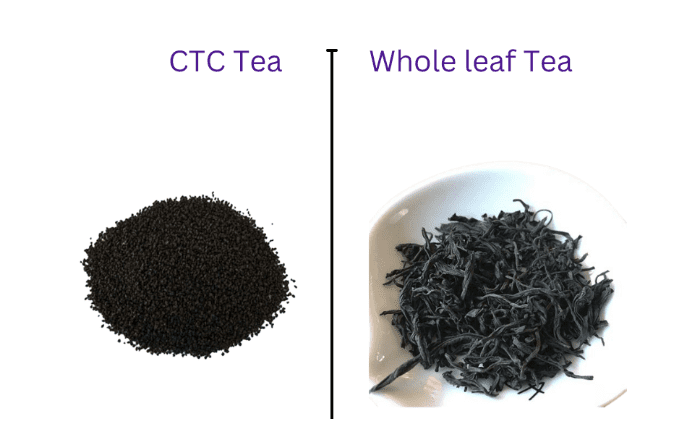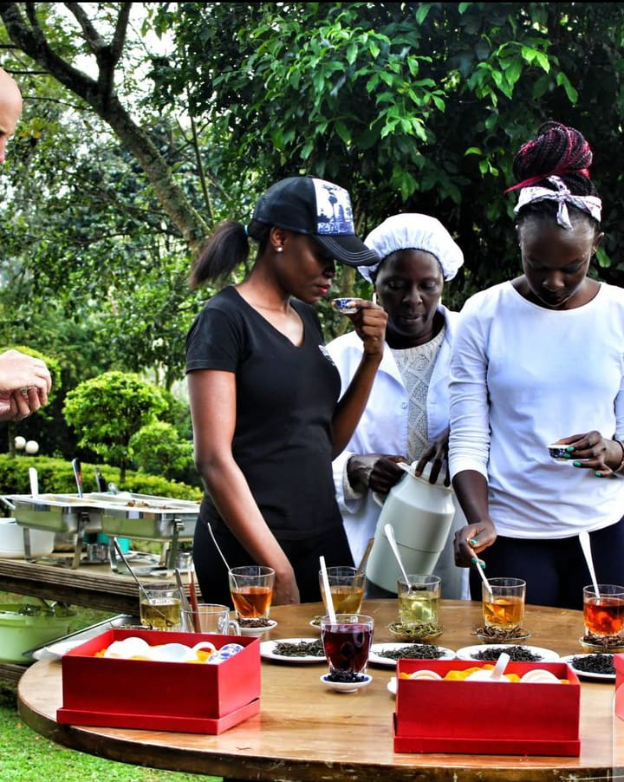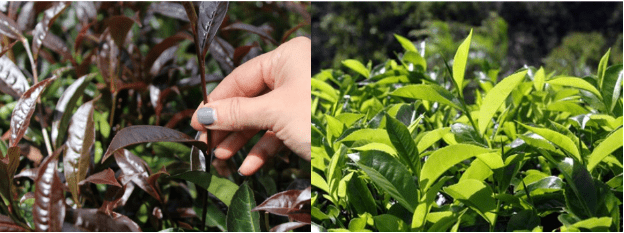What is the history of tea farming in Kenya?
Tea farming in Kenya began in 1903 when the British colonial government introduced it in Limuru. The first estates were established in 1924. However, Africans were not allowed to participate in tea farming activities, and the estates were exclusively owned by the white settlers.
It wasn’t until 1956 that the landscape of tea farming in Kenya underwent a transformative shift and Africans were allowed to participate in tea farming. Mr Kinyanjui, the patriarch of the Gatura Greens family, was among the first Africans to get into tea farming.
Why is Kenyan tea so delicious?
Kenyan tea is renowned for its distinctive taste and aroma. The climate, soil, and processing techniques are the primary factors that contribute to the deliciousness of Kenyan tea.
Kenyan tea is grown in specific regions known as tea belts. The regions are endowed with ideal climate and volcanic red soils that are rich in minerals. The long sunny days and well-distributed rainfall ranging between 1200 mm to 1400 mm per annum are the climatic features of the tea belts. The tea plants grown in these regions have a unique flavor profile that is attributed to the terroir of the region. These regions also support organic tea growth with zero use of pesticides.

Kenyan tea is distinguished from teas produced in other regions by its bold and robust flavor, bright color, and strong aroma. The unique combination of climate, soil, and processing techniques gives Kenyan tea its distinctive taste and aroma that is enjoyed by tea lovers around the world.
What is the Difference Between CTC and Whole Leaf Tea?
There are two major ways that Kenyan tea is processed, CTC and whole leaf tea. The different processing techniques affect how you experience your tea.

The main differences between CTC (Crush, Tear, Curl) and whole leaf tea lie in their processing methods, appearance, flavor profile, and brewing characteristics. Here’s a breakdown of the distinctions:
| Characteristic | CTC | Whole Leaf |
| Processing Method | Undergoes a mechanized processing method that involves crushing, tearing, and curling the tea leaves into small, uniform particles. | Whole leaf tea involves minimal processing, preserving the original shape and size of the tea leaves. |
| Appearance | Small, uniform, and granular tea particles | Retains the full, unbroken tea leaves. |
| Flavor Profile | A strong, robust flavor with a quicker infusion. | More nuanced and complex flavor profile from slower infusion. |
| Brewing Characteristics | Brews quickly and is well-suited for those who prefer a strong cup of tea without a lengthy steeping time. | Requires a longer steeping time to fully unfurl and release its flavors. The leaves may be re-steeped multiple times, providing a more economical and sustainable option. |
What is the tea drinking culture in Kenya?
Source: Nation Media Group

Tea, or Chai as lovingly referred to in Kenya, is more than a beverage. It’s a cultural cornerstone, fostering social bonds, symbolizing warmth, hospitality, and community. Tea is used to welcome guests, served in ceremonies, and enjoyed throughout the day.
Tea is consumed throughout the day, with breakfast, lunch, and dinner, and is often served to guests as a sign of respect and welcome.
Tea drinking in Kenya is steeped in tradition and customs. It is often served with milk and sugar, and sometimes with spices such as ginger, cinnamon, and cardamom.
Tea is served with food such as mandazi (a type of fried bread) and samosas (a savory pastry).Despite the love for tea, Kenyans barely consumes a small percentage of the total produced annually. In 2021, Kenyans consumed approximately 10% of the tea produced domestically, and the rest is exported.
How is Kenyan Tea Brewed?
There are different ways you can brew your tea depending on the type of tea you intend to enjoy. For whole leaf tea, steeping the tea leaves in water between 74 °C and 85 °C is the best way to enjoy the full flavor of the tea.

To prepare the tea, you can use a tea infuser or a tea strainer. Here is a simple recipe to make whole leaf tea:
- Boil water and let it cool for a few minutes until it reaches the desired temperature.
- Add a spoonful of whole leaf tea to the infuser or strainer.
- Place the infuser or strainer in a cup.
- Pour the hot water over the tea leaves.
- Cover the cup and let the tea steep for 3–5 minutes.
- Remove the infuser or strainer and discard the tea leaves.
- Add sweetener or milk if desired and enjoy your tea!
Steeping whole leaf tea at a lower temperature helps to preserve the delicate flavors and aromas of the tea. It also reduces the bitterness that can result from steeping tea at higher temperatures. Enjoy your cup of tea!
Fun fact: You can reuse your whole leaf tea leaves up to four times before discarding! Ensure you store the leaves in a cool place to avoid contamination and enjoy your tea throughout the day.
Which varieties of teas are grown in Kenya?

The two main tea varieties grown in Kenya are Camellia sinensis var. sinensis, commonly known as the green tea bush, and Camellia sinensis var. assamica also known as the purple tea bush.
The green tea bush is commonly used to make different types of tea such as black tea, oolong tea, and green tea.
On the other hand, purple tea is a relatively new variety of tea that is derived from the common tea-leaf, Camellia Sinensis, but has purple leaves due to the presence of Anthocyanin.
Anthocyanin is a flavonoid pigment responsible for the reds, blues, and purples of many flowers, fruits, buds, leaves, and roots. The flavonoids are known for their antioxidant properties and have been linked to various health benefits, such as reducing inflammation, protecting against cancer, heart disease, and type 2 diabetes, and improving glucose tolerance.
Gatura Greens is a pioneer in purple tea farming, and the first ever commercial purple tea farm.
The Kiambethu Tea Farm is the oldest tea farm in Kenya, where the first green tea bush was planted over 100 years ago.
Both Gatura Greens and Kiambethu offer tea farm tours. Gatura Greens, in comparison, offers an immersive tea tour that includes picking your own tea, processing it and keeping it as a souvenir. Having a processing plant on the farm allows us to offer guests an expansive tea tasting of over 10 different types of teas. We also have a waterfall on the farm, a short walk to a refreshing dip. Gatura Greens is black-owned and female run.
How has tea farming evolved in Kenya?
Tea farming in Kenya has evolved from exclusive colonial activity to small-scale farmers managing over a million hectares. The introduction of KTDA in 1964 empowered small-scale farmers, making Kenya the largest tea exporter today.
In addition to its cultural significance, tea is also an important part of the Kenyan economy. Kenya is one of the largest tea producers in the world, with tea accounting for over 20% of the country’s exports.
In fact, Kenya is the largest tea producer in Africa and one of the second-largest tea exporters globally, after China and Sri Lanka. According to the Tea Board of Kenya, the total tea production in Kenya in 2021 was 345,817 metric tonnes.

